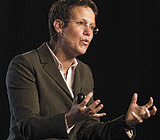YOUR BUSINESS AUTHORITY
Springfield, MO
YOUR BUSINESS AUTHORITY
Springfield, MO

Those challenges – and how to meet them – were the focus of the fifth Economic Outlook Conference Sept. 16 at University Plaza Convention Center, presented by the Springfield Area Chamber of Commerce and Springfield Business Development Corp.
The title of the conference, “New Challenges, New Opportunities,” spoke to the difficulty, as did a panel discussion on real estate trends and the day’s keynote speaker.
A new work force
Springfield, like most other cities across the country, also faces an impending shortage of workers to replace the retiring baby boomer generation.
But Rebecca Ryan, founder and president of Next Generation Consulting, thinks Springfield is better equipped to handle the situation than many communities, due in large part to the area’s number of colleges and universities.
That was part of Ryan’s message as the conference’s keynote speaker.
“You want the city’s age graph to show that the majority of people are in their earning years,” she said. “Springfield, for the most part, has that.”
U.S. Census Bureau data in 2006 shows that nearly 40 percent of Springfield’s population is between the ages of 20 and 44, while only 15 percent is 65 or older. Click here for a graphical breakdown of Springfield's population.
Nationwide, Ryan said, two boomers will be retiring for every one person entering the work force in 2012, leading to a shortage of both overall workers and management experience.
That situation, combined with a fundamental shift from a goods-based economy to one built around information and knowledge, means business leaders have to find new methods of attracting and retaining young professionals.
“We know that the way young professionals choose (jobs) is just different,” Ryan said. “We’ve talked with more than 25,000 YPs, and they all say, ‘Live first, work second. Where I live is as important as where I work.’”
The key is making the community more attractive to younger workers, and while Ryan told the crowd “there are no magic bullets” to solve the problem, there are several ways to deal with it.
The most important item, she said, is to make sure young professionals have “a seat at the table” in making decisions, which also encourages diversity of ideas and backgrounds.
Another key issue for business leaders is intra-office communication. Ryan said the issue is not only between the boomers in management and the younger workers lower in the ranks; fundamental differences between Generation X and the younger Millenials complicate the issue.
Gen X, Ryan said, was heavily protected growing up – “They were raised not to trust men with puppies, people with candy,” she said – while the Millenials were given nearly everything they wanted as children.
“So when they come in to work, you have the Gen Xers who don’t trust anybody, and then you have the Millenials who love adults and cozy up to their bosses,” Ryan said. “It creates friction.”
But, she added, the one thing they have in common is that they don’t rely on a company for job security. The majority of Millenials, she added, say that the reason they took their first job was to prepare for their second job.
“They’re very diverse, and they’re very willing to leave,” she said. “If they don’t like the job proposition you have, they’ll go somewhere else or they’ll start something themselves.”
Real estate woes
Businesses face significant pressure from the economy, and few sectors have been hit as hard as real estate.
A panel of local industry experts discussed issues the sector faces. Panelists were Matt Miller of Matt Miller Co. and Blue Block Lofts; Matt Morrow, executive officer of the Home Builders Association of Greater Springfield; and Rick Quint, president of the Springfield division of Walton Construction.
Quint said the commercial construction market is being hit by economic insecurity, which makes developers more unsure about whether to proceed with projects. Another issue is the rising prices of raw materials including asphalt and metal.
“We’ve got a situation where subcontractors, in some cases, can’t guarantee prices for more than 10 days,” Quint said.
The problem on the residential side, meanwhile, is not as much about construction. Morrow said that the three factors that lead to a strong housing market – population growth, job creation and home affordability – are all good in Springfield.
The issue, he said, is the market to buy those homes.
“The credit crunch has created a definite buyer’s market – and a shortage of qualified buyers,” Morrow said.
The issue has been exacerbated in southwest Missouri by fewer people entering the market who are “house rich,” with significant money accumulated from selling homes in more expensive markets. The reason: Those people, Morrow said, can’t sell their homes in the current economy.
Downtown, according to developer Miller, is a bright spot. The downtown residential market in particular is strong; his 75 loft units are 100 percent leased.
“Springfield has been following the national trend of re-urbanization,” Miller said, pointing to the College Station theater project and Missouri State University’s downtown investment. “That trend will continue, but it will be tempered somewhat by short-term (economic) hurdles.”[[In-content Ad]]
Missouri State University’s science building, built in 1971 and formerly called Temple Hall, is being reconstructed and updated.